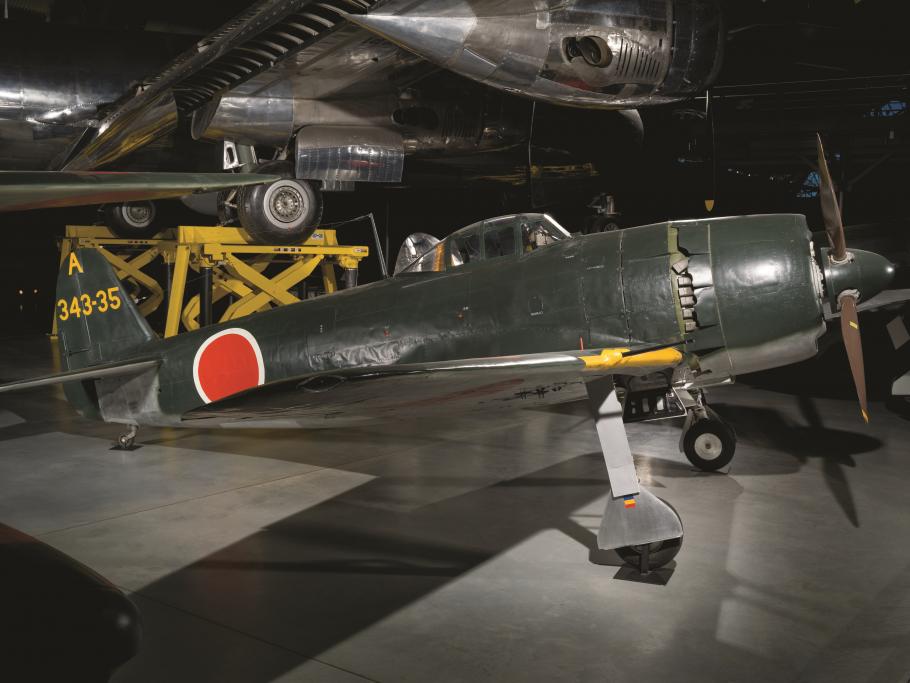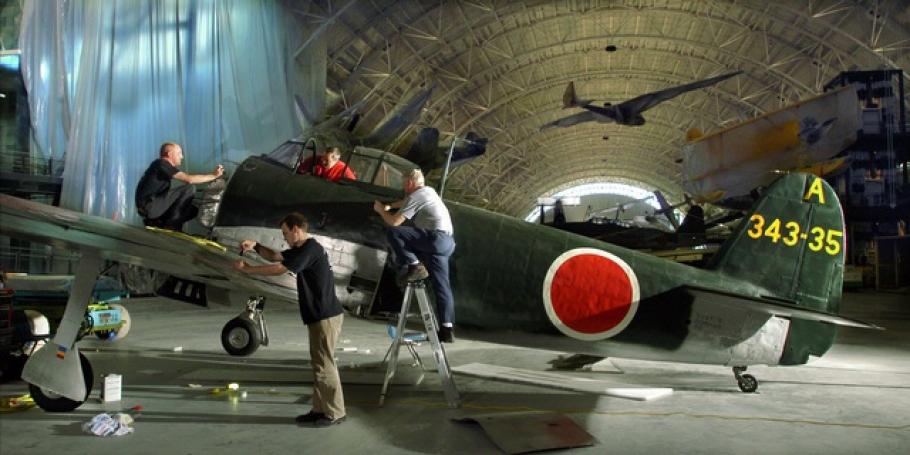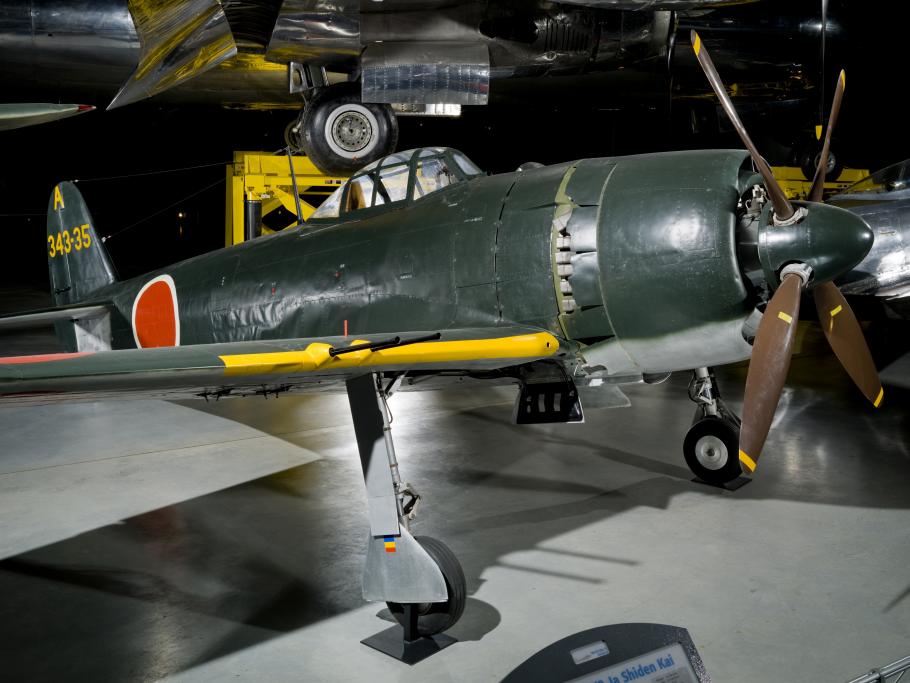GEORGE is the unlikely Allied nickname for the best Japanese naval fighter produced in quantity from late 1943 to the end of World War II. The official Japanese name and designation was Kawanishi N1K2 Shiden (Violet Lightning). This outstanding land-based fighter sprang directly from a floatplane fighter design, the N1K1 REX (see NASM collection).
Many countries used floatplanes for scouting and reconnaissance duties and to hunt submarines and surface ships. But only Japan built and fielded fighters on floats. The Japanese Imperial Navy intended to use these specialized aircraft to gain air superiority above a beachhead to support amphibious landing operations where carrier or land-based fighters were unavailable. The Kawanishi N1K1 (Allied codename REX) was the only airplane designed specifically for this purpose to fly during World War II.
In September 1940, the Japanese Navy issued a specification for floatplane fighters capable of supporting offensive naval operations. A team of engineers including Toshihara Baba, Shizuo Kikuhara, Hiroyuki Inoue, and Elizaburo Adachi had readied the first prototype by May 1942, and it flew on May 6. Tests showed that the speed of new airplane was only slightly less than the Mitsubishi A6M Zero (see NASM collection) and the amphibious fighter was almost as maneuverable as its land-based cousin. This was remarkable performance for an aircraft that could not retract or jettison its huge landing gear.
Long before the first Kyofu flew, Kawanishi engineers believed that the basic design would also make an excellent land-based fighter. The conversion appeared to entail simply replacing the main and wingtip floats with a conventional landing gear. The company decided to develop this variant as a private venture. As the project unfolded, the engineers decided to replace the 14-cylinder engine with a new 18-cylinder model expected to produce about 2,000 horsepower. The new engine required a larger propeller and this component, in turn, required abnormally long landing gear struts to prevent the blade tips from contacting the ground. Kawanishi flew the first N1K1-J land-based fighter on December 27, 1942. The new engine failed to deliver the expected power and the landing gear functioned poorly. The airplane also fell short of projected speed (649 kph - 403 mph) by 74 kph (46 mph) and could manage only 575 kph (357 mph). This was faster than the Mitsubishi A6M Zero ZEKE, however, and the Japanese Navy badly needed an effective counter to new American naval fighter aircraft such as the Grumman F6F Hellcat and Vought F4U Corsair (see NASM collection). The Japanese Navy ordered Kawanishi to abandon two other fighter projects and start building Shidens.
By the end of 1943, Kawanishi delivered about 70 of the new fighters and the Navy used these airplanes for pilot familiarization and training. Expecting Allied amphibious landings in the Philippines, the Navy sent the first Shiden unit to Cebu in time to challenge Allied air power supporting the invasion of that island in October 1944. Engine, landing gear, logistics, and maintenance problems plagued the Shiden units but Allied pilots realized they faced a superb new Japanese fighter.
With N1K1-J production underway and Shidens flying combat missions, Kawanishi set about refining the design. They lowered the wings from mid-fuselage and the extra ground clearance permitted the engineers to install a shorter, more conventional and less-troublesome landing gear, simplified the fuselage structure, and redesigned the empennage. Only the wings and armament remained from the initial design. The engine continued to give trouble, but the Navy was impressed with these improvements and ordered the new version into production as the N1K2-J Shiden-kai (modified). In air-to-air combat, experienced Japanese pilots flying the Shiden-kai could more than hold their own against most American pilots flying F6F Hellcats. In February 1945, a brave pilot, Warrant Officer Muto, single-handedly engaged 12 Hellcats and shot down four of them before the remainder disengaged. Flying intercept missions against Boeing B-29 Superfortresses above the home islands, the Shiden-kai was less successful because of inadequate climb speed and power loss at high altitudes.
Kawanishi developed several other variants and planned more when the war ended. About 1,500 of the various models were produced. In battle over Formosa (Taiwan), the Philippines, Okinawa, and the home islands, Shiden pilots acquitted themselves well but this excellent airplane was another good design that appeared too late and in too few numbers to reverse Japan's fortunes in the air war.
NASM's Shiden-kai is one of four remaining today. One is displayed at the National Museum of the U. S. Air Force in Dayton, Ohio, one at the National Naval Aviation Museum in Pensacola, Florida, and another example is displayed at Misho Park, Ehime Prefecture, Japan. American intelligence units collected four GEORGE fighters from various Japanese airfields and delivered them to Yokosuka Naval Shipyard for shipment to the United States. The NASM GEORGE came from Omura or Oppama Naval Air Station, Japan, and the fighter arrived stateside aboard the escort carrier "USS Barnes." It was probably evaluated at the Naval Aircraft Factory at Philadelphia, and then moved to Willow Grove Naval Air Station. The GEORGE remained outdoors on display and steadily deteriorated along with a group of German and Japanese airplanes until 1983 when the Smithsonian Institution acquired it. The airplane was stored at the Paul Garber Facility until NASM loaned it to the Champlin Fighter Museum in Mesa, Arizona, for restoration in December 1991 and the project was completed in November 1994. The restored Shiden-kai wears the colors and markings of the 343rd Kokutai, a unit commanded by the man who had planned the 1941 attack on Pearl Harber, Minoru Genda.





